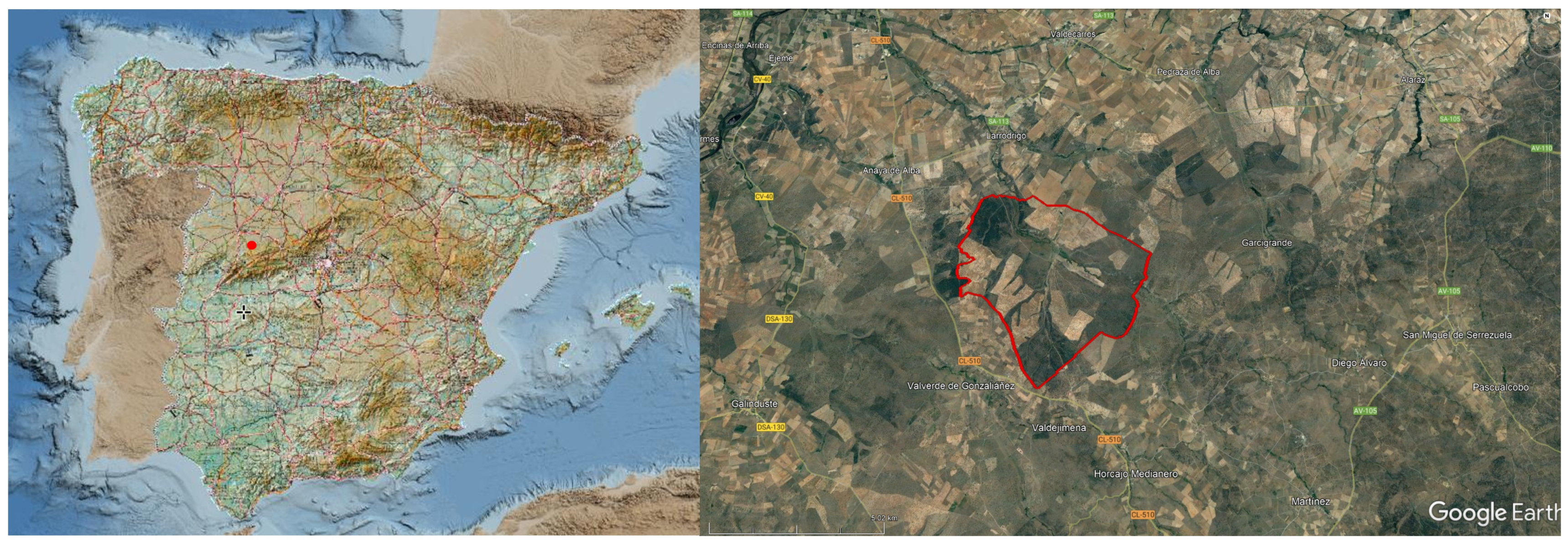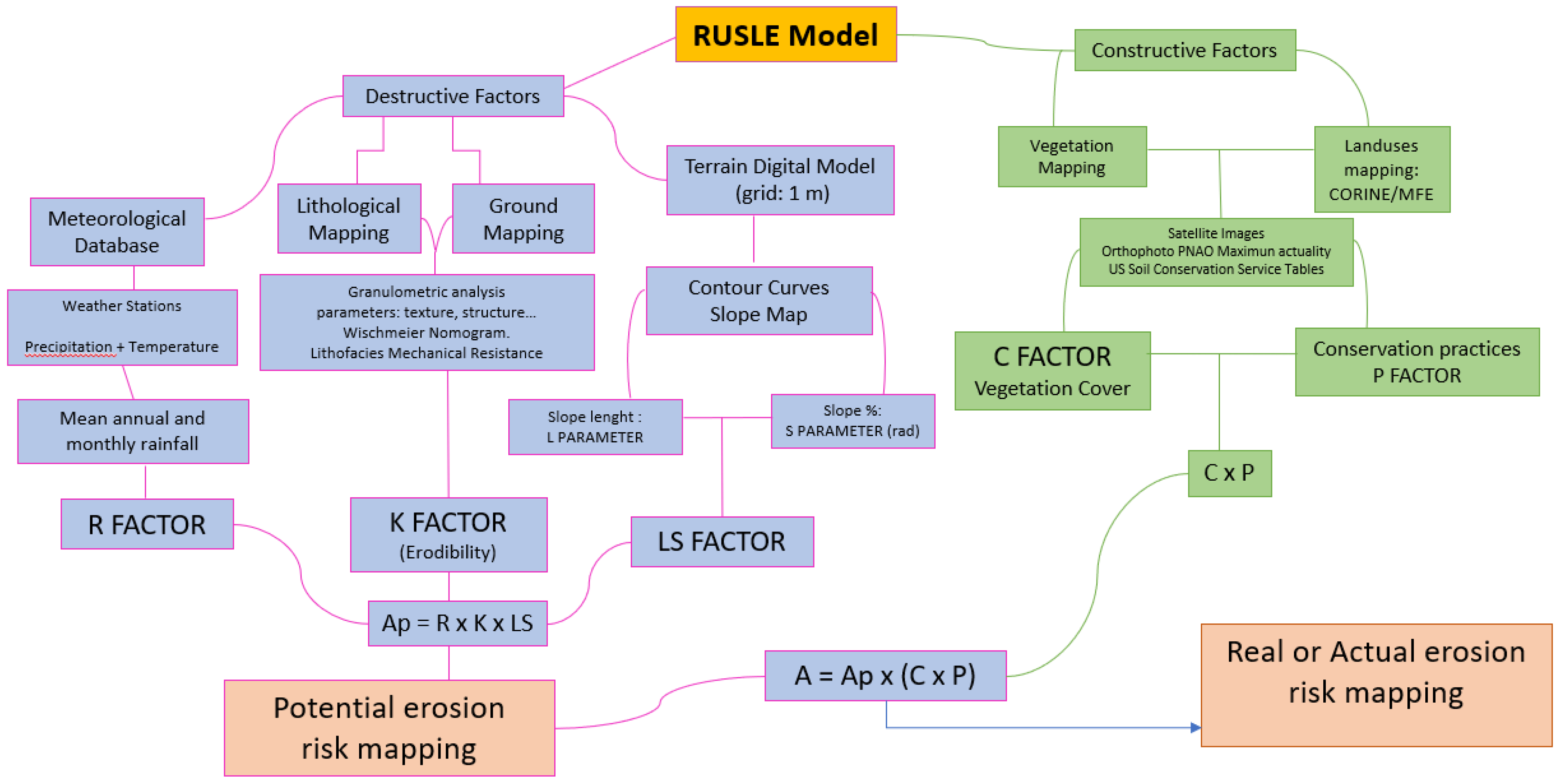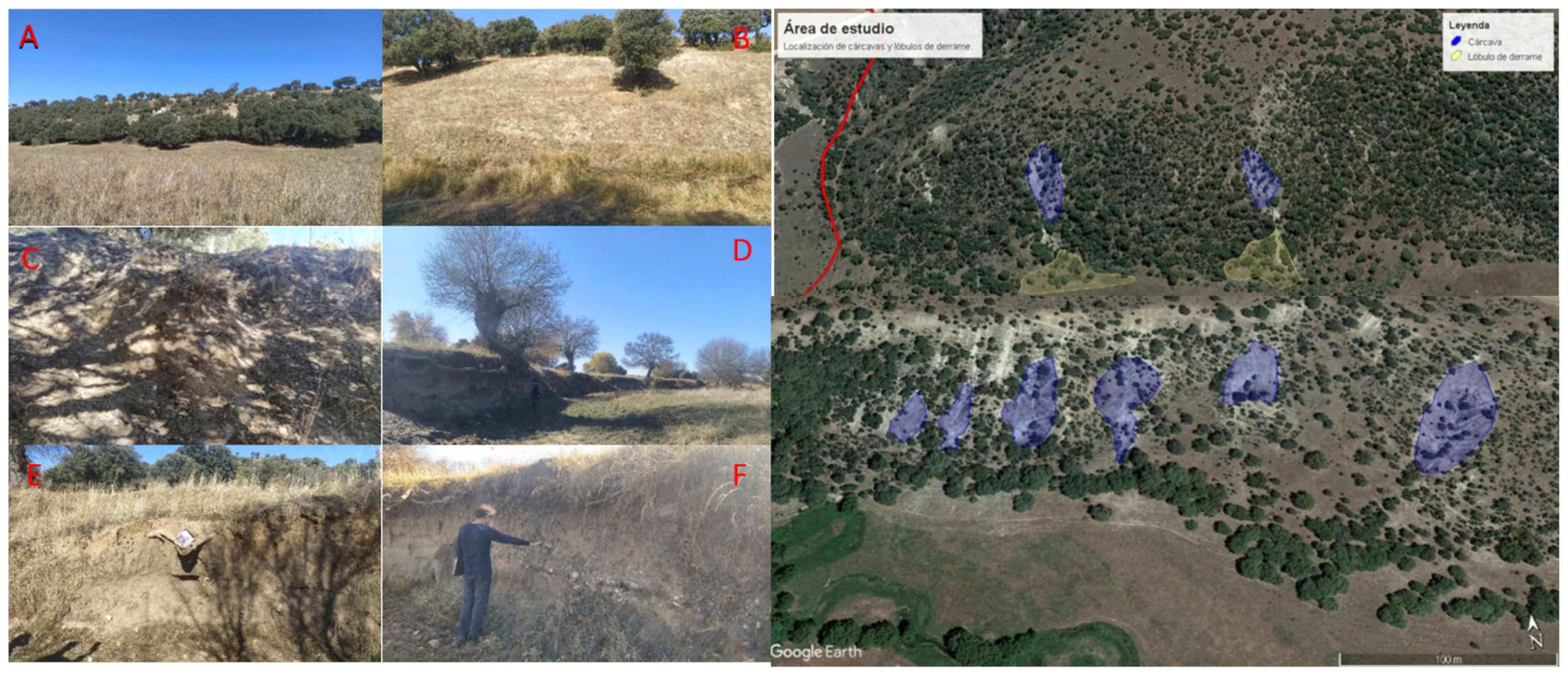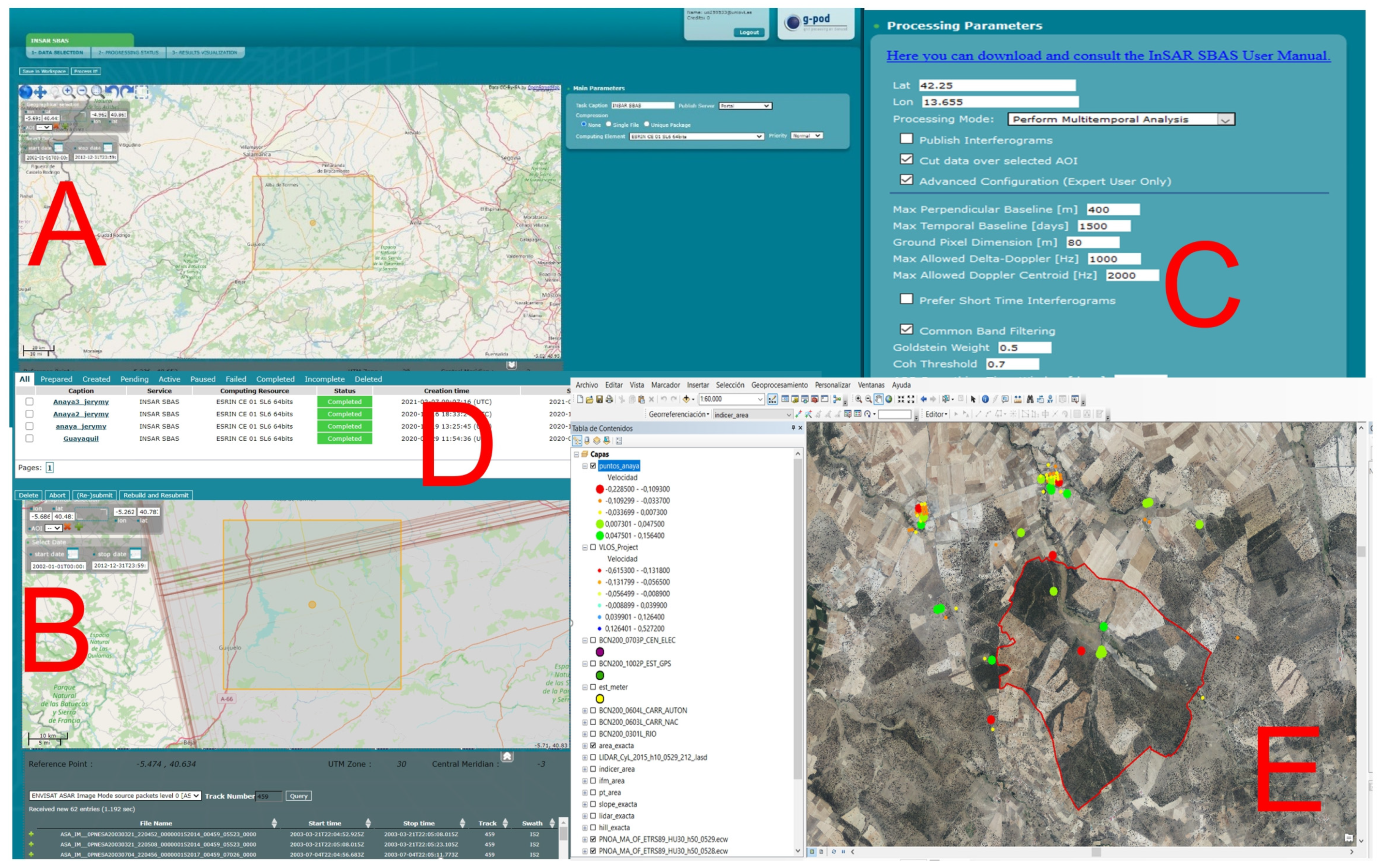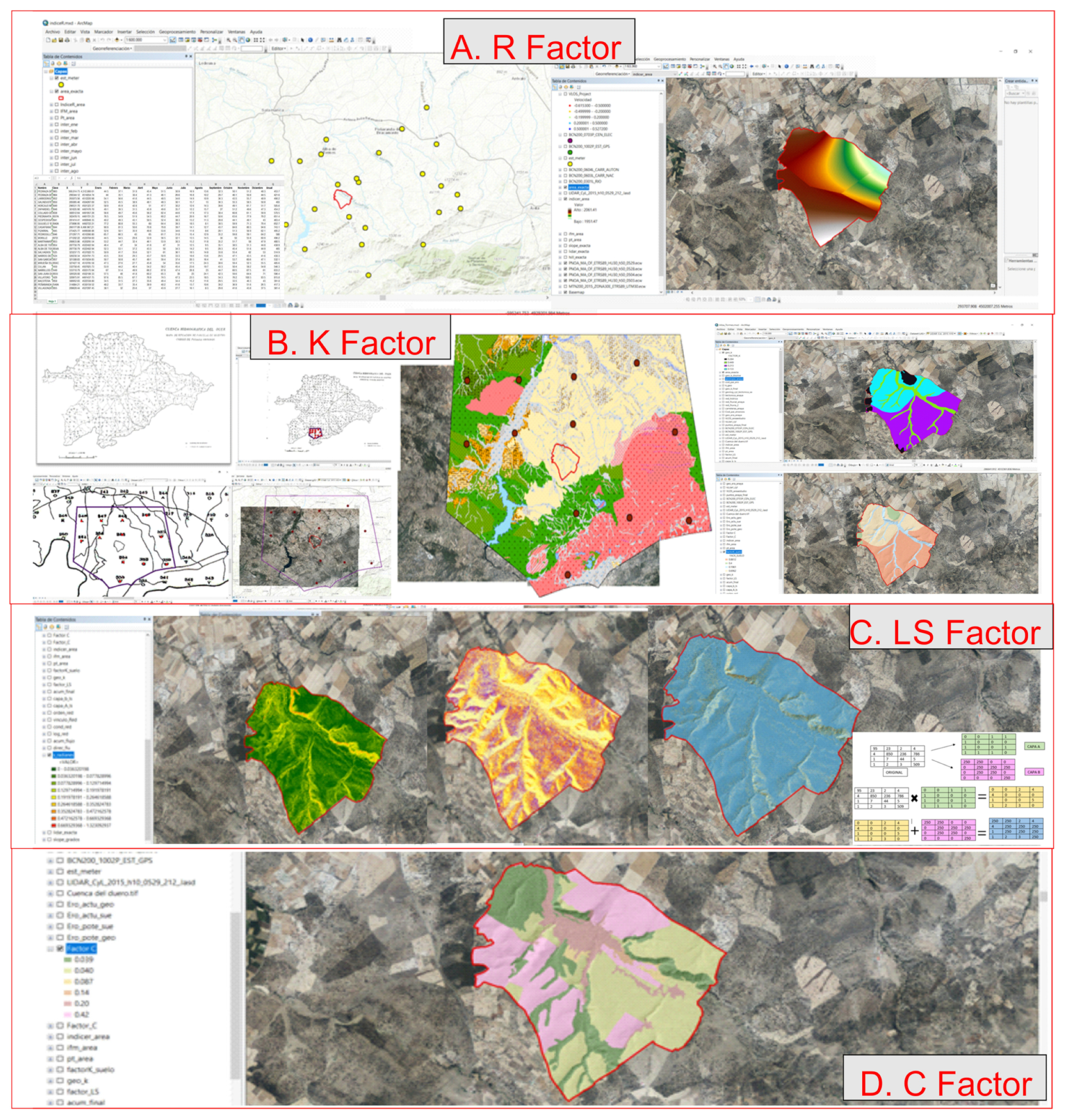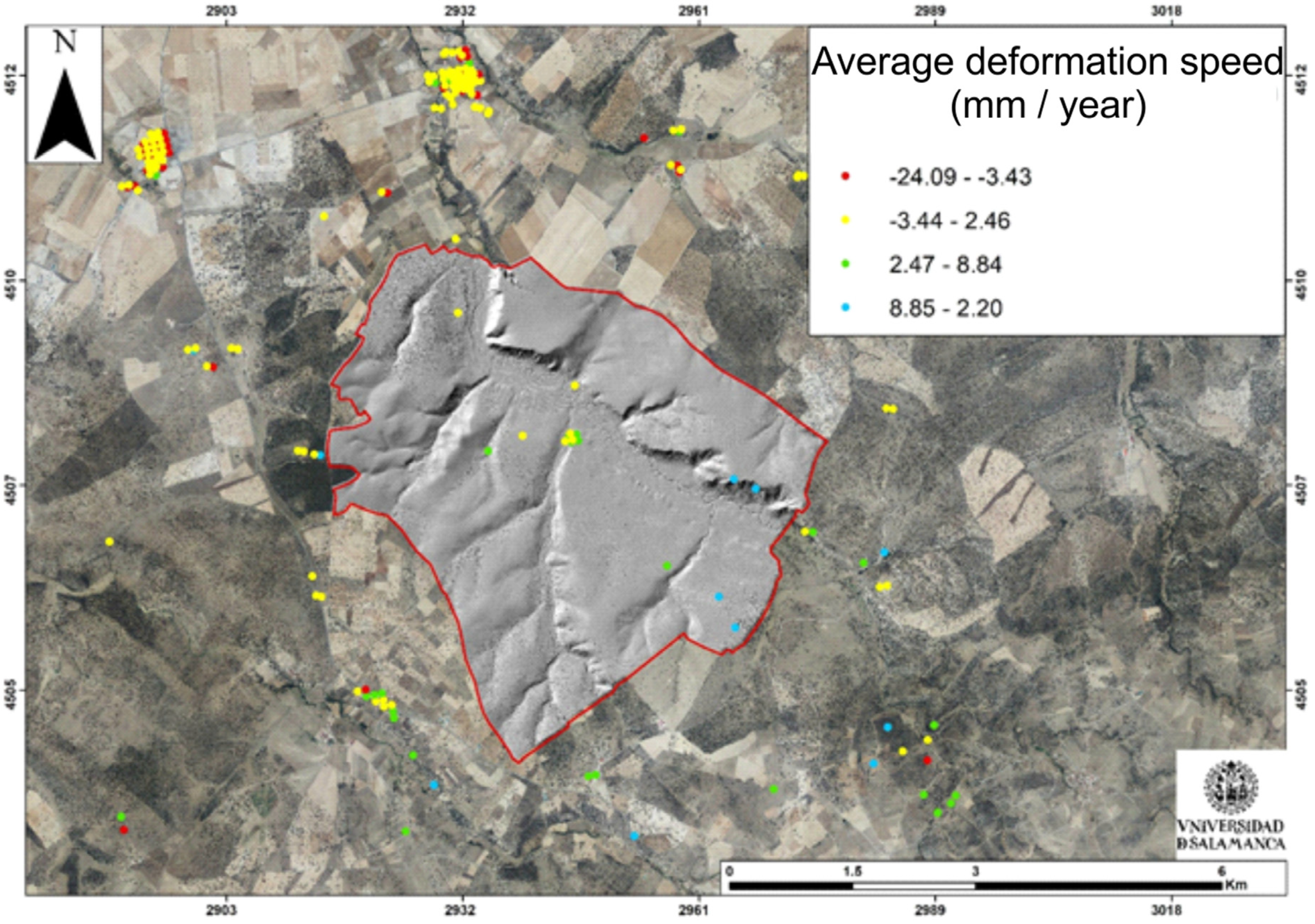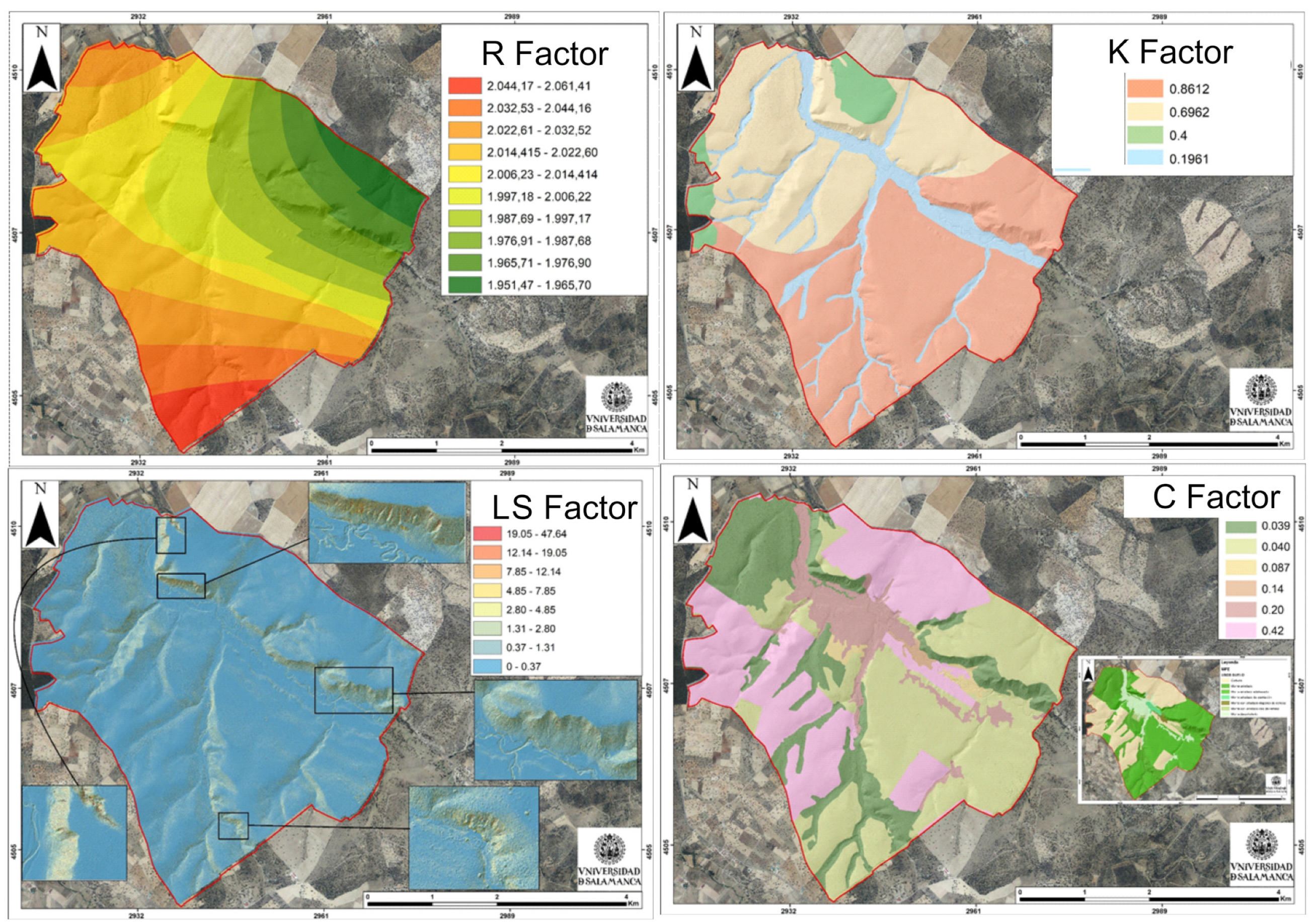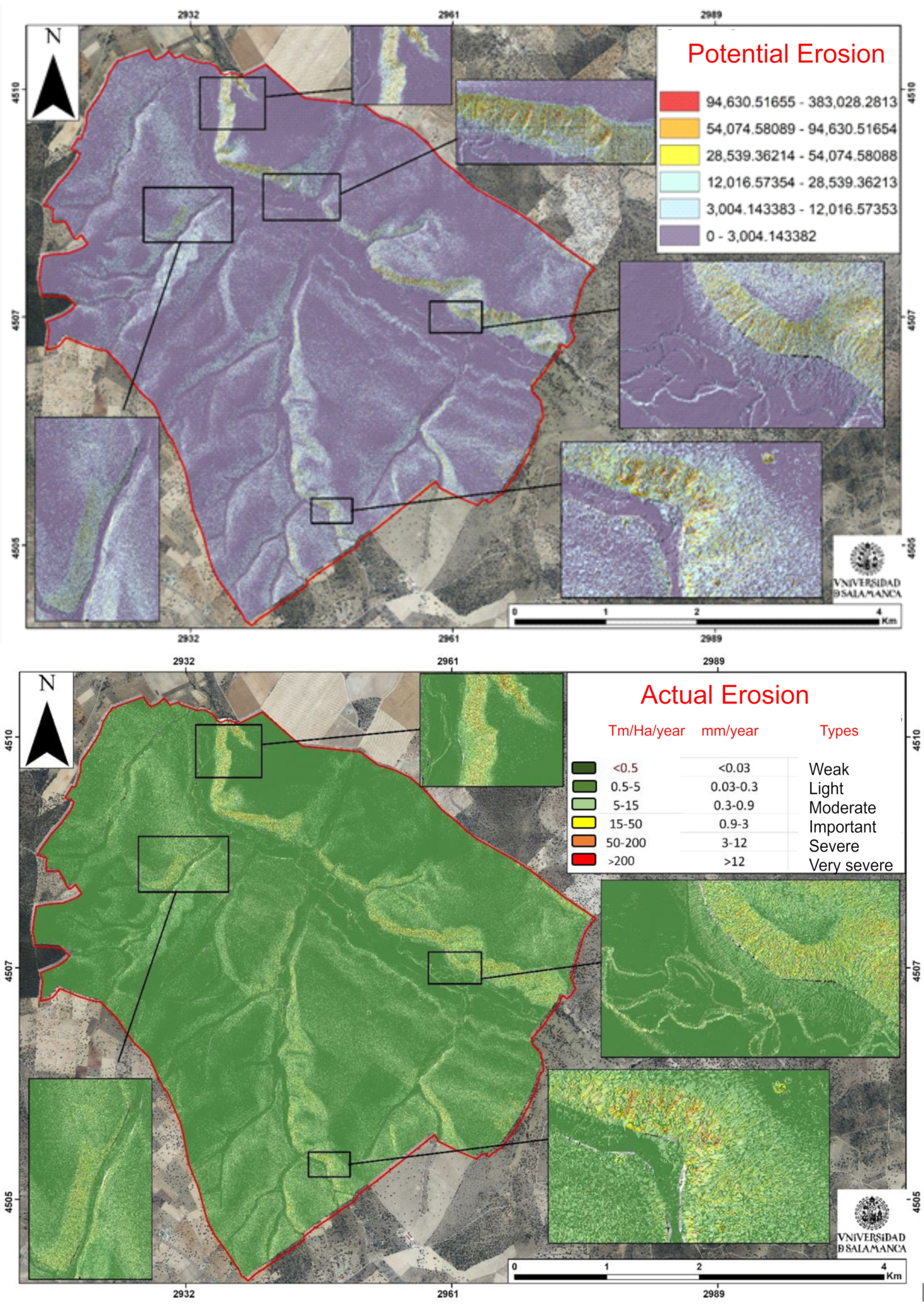1. Introduction
The risk of soil erosion is an issue that has become very important over the years, because soil degradation can cause important environmental impacts and high economic costs, through its effects on the agricultural production, infrastructures and water quality that, in turn, affect the well-being of citizens, potentially threatening their security and representing a serious problem for the sustainable development of the population. On the other hand, organic carbon emissions can be generated from the soil into the atmosphere in the form of CO
2, thus accentuating the effect of global warming [
1]. These erosive processes are characterized by being relatively slow and intermittent, although periodic over the years. However, as a consequence of inadequate soil management, erosion from agricultural land can be very intense. Furthermore, soil degradation by erosive agents (water and air) is considered progressive and irreversible since, on the one hand, the volume of soil lost is usually irrecoverable and, on the other, the time required for it to form again, the floor is extremely long [
2,
3,
4].This work will focus on the risks of sheet water erosion or surface rill due to precipitation, which consists of the loss of a more or less uniform layer of soil on a sloping terrain, which mainly affects the released particles by splash. This occurs mainly in situations where the intensity of precipitation exceeds infiltration or when the soil becomes saturated with water, resulting in excess water on the surface. Surface runoff transports the finest particles and causes a decrease in soil productivity (loss of clay, organic matter and nutrients). When the irregularities of the terrain and the greater dolawnstream flow cause the laminar flow to become concentrated, we speak of erosion by furrows, gullies and ravines that represent the three degrees of development of this process. The grooves are centimetric in size and can disappear when carving, the gullies are decametric to metric and generally cannot be removed with ordinary tillage and finally, the gullies are incisions of several meters, even dozens. The result of erosion by gullies and ravines is the dissection of the affected land [
2,
5]. The area affected by water erosion, as well as its total intensity and magnitude, can be increased by deforestation, forest fires, traditional tillage systems, etc. The absence of plant cover means that the impact of the raindrop not only causes disaggregation, but generally results in the formation of a superficial crust that affects the first millimeters or centimeters of the tillage horizon. This phenomenon is a consequence of the displacement of clay and silt particles that occupy the pores of the soil, causing their occlusion. With this, the infiltration intensity decreases, which favors the initiation of surface runoff [
6]. In turn, the same soil, exposed to the action of the same rains, undergoes different erosion intensities depending on whether it is in the upper, middle or lower part of a hilside, and depending on slope (relief effect). Another thing to keep in mind is that the resulting erosion also varies depending on the type of vegetation that protects the soil, the cultivation practices or the use of said vegetation, its disposition with respect to the slope of the slope, and so on. These last two factors, relief and vegetation cover, are what make the erosive action of rain vary on the erodibility of each soil, resulting in different erosion rates in each case, which can be evaluated through the estimation of the effect of each of these factors mentioned.
On the other hand, the application of techniques through Geographic Information Systems (GIS) in environmental studies, allows analysis of the different geospatial databases of the territory to be studied. It is commonly used in areas such as environmental planning and protection, natural resources, natural risk analysis (geomorphological and hydrological modeling, etc.), or the generation of georeferenced thematic cartographies, establishing different analysis methods and models of process simulation [
7,
8]. The quantification of erosion in the last decades has been carried out by various methods such as USLE, SWAT, MUSLE, PESERA, EUROSEM, etc. which analyze the erosive process considering a static natural environment. For this reason, GIS and remote sensing techniques have made it possible to develop and quantify the parameters that intervene in the erosive process dynamically and with more exact techniques and platforms that have currently been developed (lidar data, satellite images resolution, cartography landuse CORINE-SIOSE, etc). In this article, to detect, monitor and model the erosion risks found, GIS techniques have been used together with the Revised Universal Soil Loss Equation (RUSLE) model, allowing the generation of different thematic cartographies of the territory, for the subsequent analysis of the possible emerging erosion risks (erosive, hydrological, ground movements, geotechnical) and environmental analysis of anthropic actions in the natural environment, at different scales. For the analysis of mass movements or sediment flow there are numerous techniques. The detection process can be carried out: (i) on a local scale, using monitoring systems with sensors such as deformometers, biaxial inclinometers, load cells, flow meters, piezometers, etc. (SIAP MICROS, 2003), which allow alerting in real time, each small landslide or, (ii) at a regional scale through the combined use of the techniques: Geographic Information Systems (GIS) and Advanced Differential Interferometry SAR (A-DInSAR). The Differential Synthetic Aperture Radar Interferometry (DInSAR) technique is based on the calculation of displacement maps of individual events calculating the phase difference (interferogram) of two SAR images obtained over the same acquisition area and orbit, separated in time, allowing the study of the deformation produced by the displacements of the terrain of any area of the planet in a given period of time. Since the beginning of this century, different advanced techniques (such as A-DInSAR) have been developed that allow analysis and studies of slope instabilities and subsidence phenomena through the acquisition and processing of a large number of SAR images, and therefore, of a large number of interferograms [
9,
10,
11,
12]. One of the most widely used techniques is the Parallel Small Baseline Subset (P-SBAS), developed and incorporated into the free-to-use platform Grid-Processing On Demand (G-POD) [
13]. The SAR images used by this platform come from the ERS-1 and 2 (1991–2011) and Envisat ASAR (2002–2012) satellites. In our case it has been applied to be able to detect, monitor and model differential flows combining A-DinSAR and SIG [
14,
15].
Due to the importance of soil as a fundamental resource for life and the development of anthropic activities, the objective of this work is to quantify the risk of water erosion in an area such as Larrodrigo, with a high capacity for agricultural activity, simultaneously applying the RUSLE method and GIS techniques (ArcGis 10.9, Esri, Madrid, Spain), in order to know the high potential for water erosion risks in the study area. On the other hand, it is intended to detect trends of sediment flows within and in the surroundings of the study area, from the automation of thematic cartographies by means of algorithms obtained from DTMs in order to detect ground movement by applying DinSAR techniques. Finally, for the quantification and calculation of the risk of water erosion, different thematic cartographies generated and mechanized with GIS will be obtained.
3. Results and Discussion
A series of results have been obtained from all the calculations carried out for each of the relevant factors of the study area by applying the RUSLE model, as well as the estimated values of average velocities (mm/year) of sediment movements and coherence to from the A-DInSAR processing, related to geological parameters of the study area.
3.1. Analysis of Ground Deformation Velocities (mm/year)
A series of points has been obtained from the application of the A-DInSAR technique of average ground deformation speeds in mm/year (
Figure 7). Due to the limitations of the technique, it has been determined that the results obtained from are not valid and/or insufficient because the scale of the study area is too small for the application of tools of this style. In addition, the study area is located in areas with few essential urban reflectors for taking satellite data, which further limits its use. Finally, the presence of dense vegetation accentuates the difficulty of penetrating the satellite laser when collecting data, so this technique definitely contains numerous limitations for this type of study area. In any case, points with average ground velocities of −24.09 mm/year have been found, although very few points have been detected within the perimeter of interest. The positive data found in blue color can indicate the satellite’s approach to the ground, bulging or swelling of the ground or simply atmospheric noise, making this uncertainty invalidate this type of data obtained.
3.2. R Factor or Pluvial Erosivity
It can be seen that the pluvial erosivity values of the study area oscillate between 1951.47 MJ·mm/Ha year–2061.41 MJ·mm/Ha year. There is an increasing trend of the aggressiveness of the rain from the NE zone towards the W-SW, marked by a maximum located in the SW corner where the greatest pluvial erosivity occurs, registered with values in 2061.41 MJ·mm/Ha/year. This maximum is due to the fact that it is positioned on flat areas that contain a gentle slope, causing it to favor the flow of sediments dragged by the water due to precipitation, which the fall impact due to the splash effect easily disintegrates and unstable the sediment of the water ground. On the other hand, the plots with less rainfall erosivity, located to the NE, are located on the flat terraces of the main river, which due to their morphology receive less volume of lateral water and therefore suffer less erosion, since they transport less sediment, some of which can be decanted in times of lower energy, with values between 1.951–1.987 MJ·mm/Ha/year. These types of areas eventually receive rainfall varying its intensity. Ultimately, the key to the R factor is that its increase is due to the presence of areas with steep decline, which favors the flow of water and the dragging of sediment to act as the main erosive factor (
Figure 8).
3.3. K Factor or Resistance to Erosion
This factor shows the erodibility or erodibility of the soil from physical properties, considering the lithology (
Table 1) and validating our results with the cartography of erosive landscapes of the Duero River hydrographic basin.
This factor is directly related to the geological map of the studied plot, so the resistance to erosion varies depending on the existing lithology. For this specific case, it must be considered that the value of the K factor varies between 0–1, where 0 are conditions more susceptible to erosion and 1 condition are less susceptible to erosion. Values ranging from 0.133 to 0.499 Tm·Ha·h·MJ
−1·Ha
−1·mm
−1 are found, where the zone with the greatest resistance to erosivity is found on the alluvial deposits and valley bottoms since they contain granulometries of clay size which are compacted and adhere, that is, they coalesce, forming a film that is difficult to erode. On the other hand, the most vulnerable areas are those areas with sand-sized granulometries (almost the entire study area, except for the terraces and valley bottoms) which are easily transported by sheets of water causing significant erosion in their wake. The northern area of the study area can be highlighted as the one that suffers the highest soil erosion depending on the rocky substrate with a value of 0.133 Tm·Ha·h·MJ
−1·Ha
−1·mm
−1 as it contains granulometries of coarse sand with ridges, causing greater erosion due to its size. If we consider the existing soils on the lithological substrate and their analytical data of texture and structure from the samplings carried out in the study area. K values vary between 0 (condition least susceptible to erosion) and 1 (condition most susceptible to erosion) contrary to lithology. The resistance to soil erosion contains values ranging from 0.1961 to 0.8612 t·Ha·h·MJ
−1·Ha
−1·mm
−1, fluvisols-type soils being the most resistant to soil erosivity due to the fact that they are cohesive soils, with a greater amount of silts and clays, difficult to erode while passing of a sheet of water, showing values of 0.1961 t·Ha·h·MJ
−1·Ha
−1·mm
−1. On the other hand, the soils located on arches: fundamentally cambisols, are of less resistance to erosion, since they are detrital soils easily eroded by the flow of water, because the sand grains are not connected and are easily transported, being visualized values of 0.6962–0.8612 t·Ha·h·MJ
−1·Ha
−1·mm
−1 (
Figure 8).
3.4. LS Factor
Both the length of the slope and its slope influence the erosion rates of the soils in our study area considerably, being the geomorphological aspects related to the forms of the relief one of the main factors that determine the emission of sediments catchment areas. Regarding the length of the slope, it is known the existence of a zone practically without erosion in the highest parts of the slope, the appearance of erosive phenomena of greater intensity in the middle part and sedimentation as the dominant process in the lower part of the slope, where in general its slope decreases. This distribution of erosion occurs in a generalized way on the slopes close to the channels through which the water flows from the study area. Observing the results obtained, it can be seen that soil losses per unit area increase with increasing length of the slope, being greater in its lower part, due to the fact that the runoff sheet accumulates downstream, increasing its drag force as it descends the slope by the action of gravity. On the other hand, on longer slopes the appearance of rills is more frequent, with which erosion rates are considerably increased, as the waters concentrate in these small channels, increasing their speed and transport capacity of the particles eroded soil. The L and S factors are dimensionless and the results obtained vary between 0–47.64, the areas with the greatest erosivity being those with the greatest slope and length of the slope located mainly in the north and northeast of the study area, the existing slopes being that there are between the terraces and the valley bottoms of the main stream. There are also secondary zones with significant erosion potential located to the south and west, caused by secondary channels generated from the main stream (
Figure 8).
3.5. C Factor
In our study area, the analysis of the vegetation shows the indicated values (
Table 2). In this factor, stonyness must be considered, which is the proportional decrease in erosion due to the percentage of soil covered by fragments of rock or gravel. Vegetation cover is a determining natural element when studying soil protection against the erosive force of precipitation, since it not only controls the energy with which raindrops reach the soil surface, but also the speed of surface runoff.
The study area is covered mainly by permanent vegetation, causing that the calculated C values are only related to the coverage percentages of the fraction of the room covered by the vegetation, and the herbaceous vegetation, of lower height, varies the protection of the soil throughout the year as a consequence of management (tillage, pruning, etc.) or the development of the plant itself (leaf fall, flowering, etc.). It must be considered that the values of the C factor obtained express the relationship that exists between the annual average soil losses of a plot with a certain vegetation and the losses that that same plot would have under conditions of continuous fallow and tillage according to the maximum slope.
In our sector there is great variability in the values of factor C. The areas where there is a high density of vegetation cover and in contact with the ground, are the areas most resistant to water erosion caused by rainfall, since this cover acts of main protective shield, referring to sectors with values of the C factor of 0.42, 0.20 or 0.14 corresponding to crops, bare forest (formed by grasslands and/or grasslands) and scattered wooded forest of pasture. Being in contact with the ground, the height of fall of the raindrop is lower and therefore contains less erosive energy, which causes greater protection, on the other hand, this type of vegetation obstructs the flow of surface runoff drastically reducing its speed causing it to significantly reduce the erosive power of the water flow, causing the edaphic surface to suffer less damage. In addition, this type of vegetation may have plant remains provided by the existing cover in the study area, which cover the soil and therefore make it more resistant to water erosion, reducing the effect of aggressive rain. On the other hand, the sectors that contain values of the C factor of 0.087, 0.040 and 0.039 corresponding to wooded mountains, wooded forests pastures and wooded forests of thin dehesa formed by hardwood forests and a combination of vegetation mainly, contain less protection against water erosivity due to the fact that they are large vege-tations with crown heights and raindrops falling several meters, making the incidence of rain aggressiveness higher, since the raindrop falls with greater energy accentuating its erosivity. In addition, the speed of the flow of surface runoff through this type of vegetation is higher than in the previous case, since the arboreal permeability and without almost any plant barrier through the soil, cause them to have greater vulnerability to erosion generated by the flow of water.
3.6. Potencial Erosión Risk
Mapping potential erosion (
Figure 9) shows the susceptibility of this area to erosion, considering the existing conditioning factors. To generate the potential risk of soil loss, these factors of the physical environment that condition the erosion processes are multiplied, that is, the factor R, K and LS. Taking these factors into account, it is classified and mapped based on the erodability indices (lithology-soil science and slopes) and erosivity indices (rain aggressiveness). The results in our area show that areas near the main channel (Larrodrigo River) suffer greater processes of water erosion. The main erosive zones are located in the N-NE zone with values of 9,534.735–347,322.90 Tm/Ha/year, leaving certain significant erosive traces such as gullies and even ravines with their associated spill lobes. These areas with high potential for erosion are due to the fact that they contain the steepest slopes of the entire perimeter of interest with the presence of sand-type granulometries, which act as erosive agents when dragged by surface runoff. On the other hand, other areas with significant vulnerability to water erosion are located in secondary tributaries that originate from the main one that are positioned in the south-southwest part of the study area, focusing the erosion on the slopes formed on both sides of These secondary channels, although it contains less intensity due to the presence of a lower slope, exists. In the case of the areas with greater resistance to erosivity, they are distributed throughout almost the entire study area with values ranging between 0–1326.05 Tm/Ha/year, in horizontal flat areas where erosion hardly develops due to to the morphology of the terrain and the little influence that soil erosive agents have. In the field analysis, several videos have been made with drones that show the high degrees of incision of the erosive processes (see video gullies in
Supplementary Material) (Supplementary Materials: Video S1: Badlands-gullies).
3.7. Actual Erosion Risk
In this section, the current erosion risk is analyzed and mapped (
Figure 9), starting from the potential erosion risk and subtracting the protection offered by the vegetative cover based on its characteristics (height, density, stratification and spacing). territorial). The classification of the degrees of water erosion obtained with these thematic cartographies is regrouped in the intervals established by the Food and Agriculture Organization of the United Nations (FAO) expressed in Tm/Ha/year and mm/year.
The results of the current erosion show that the areas that suffer the greatest processes of water erosion fall mainly in areas close to the main stream that runs from top to bottom in the study area (Larrodrigo river), with current water erosion ranging from important- moderate to very severe or irreversible with values ranging between 5 → 200 Tm/Ha/year with soil losses ranging between 0.3 → 12 mm/year, mainly differentiating the N-NE and S-SW sectors of the study zone. These are sectors that contain high slopes where surface runoff flows at high speed, dragging sand and gravel, causing intense erosion and incision in its path. In addition, they contain vegetation that has little protective power, since they are wooded mountains with multi-meter crowns with hardly any vegetation on bare soils, further accentuating their erosive vulnerability. The rest of the study area corresponds to areas with great resistance to erosivity, since the morphology of its terrain with absence of slope, finer granulometries such as clays and its vegetation in contact with the ground makes it well protected to water erosion caused by rainfall, with values of <0.5–5 Tm/Ha/year with losses of >0.03–0.3 mm/year mainly, being a weak and/or slight soil loss.
4. Conclusions
The modeling and automation of the RUSLE model with GIS allows a detailed and exhaustive multiparametric analysis that facilitates the analysis of the risk of water erosion in any territory where active processes are produced by sediment movements. The generation of a geodatabase, based on the determining components of the territory, has allowed obtaining the potential and actual erosion maps, being able to establish the volume of the problem in the study area, in such a way that soil losses are calculated and quantified by water erosion. Simultaneously, the combined use of A-DInSAR and GIS techniques was used to identify the possible movements of the sediment from differences between satellite images and observing the deformation speedb of the terrain associated with mass movements due to instability of slope and subsidence phenomena within the study area. It has clearly been shown that the use of this type of DInSAR techniques linked to the size or scale of the study area are not compatible when it comes to obtaining valid and consistent results, being more accurate in larger areas and where there is a greater number of receivers or urban helmets essential for taking satellite data. Two different sectors are defined by their erosive degree. The first presents levels that go from moderate to very serious or irreversible with values that oscillate between 5 → 200 Tm/Ha/ year with losses of the land of 0.3 → 12 mm/year. This sector corresponds to areas near the Larrodrigo river, encompassing the slopes that connect with the terraces positioned to the N and NE of the study area, with a high degree of water erosivity due to the presence of very high slopes and where the vegetation is scarce, generating erosive forms of great incision in the land (gullies) that put at risk the sustainable livestock and agricultural activity of this sector. The other sector corresponds to secondary channels perpendicular to the main one, located in the W and SW part.
According to the erosion rates observed among the different land uses, it should be noted that the main conversions in land use occurred between croplands with trees and open areas of pasture, which became holm oaks with dense areas shrubs, mainly the result of the lack of forest management, being observable in the southern and western areas of the studied sector. As a result, the current rate of erosion on the farm is lower due to the protection that the holm oaks and permanent pasture provide to the soil. The open areas dedicated to cultivation have higher rates than the holm oaks. On the other hand, the prairie areas present low rates of erosion, similar to holm oaks, the result of the dense herbaceous cover that covers them.
However, particularizing within each type of land cover, important differences were observed. The case for the use of the land of holm oaks stands out, in which erosion rates are usually minimal due to the protection provided by the vegetation and the smooth orography in which they are usually found. However, the wooded areas on the right bank of the Larrodrigo stream (also observable on a smaller scale in other smaller streams), with predominant land use of holm oaks, present the highest erosion rates, so the use of the soil Holm oak brings together the upper and lower extreme values of the erosion rate on the farm. These high rates of erosion in the escarpment areas are mainly due to their steep slope, which is further enhanced by a significant absence of herbaceous vegetation due to the absence of fertile soil, the loss of which has been accelerated by the trampling of the cattle found here over time.
The cartography of the potential and current erosion risk of water erosion allows to establish in a simple way, as applied in the methodology presented in this article, the classes of degrees of erosion obtained according to the FAO, expressed in Tm/Ha/year and mm/year. This thematic mapping constitutes in itself a low-cost non-structural measure that helps to identify the areas or sectors where the implementation of a soil management and conservation plan is necessary and urgent, such as management in the change of land use. land and reforestation, as well as detecting restoration measures and adaptation of land uses. In addition, it is possible to identify areas with high rates of sediment production that constitute areas susceptible to edaphic loss and to determine the location of sediment retention structures and other measures determining the true effect on anthropic activities of first need since the Soil is a resource that is difficult to remove at the speed with which it is lost, as shown in the ratios of the cartographies carried out.
